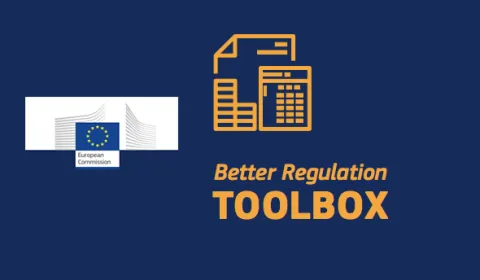
Following the 2021 Communication on “Better Regulation - Joining forces to make better laws” and the publication of the Guidelines on the principles that the European Commission follows when preparing new initiatives and proposals and when managing and evaluating existing legislation, the European Commission published the Better Regulation Toolbox.
The toolbox complements the guidelines and presents guidance, tips and best practice. Users are not expected to apply each tool, but tools linked to the requirement of the guidelines, the Commission's working methods or political commitments must be applied. As explained in Tool #1 on principles, procedures and exceptions.
The toolbox is divided into 8 chapters and 69 tools:
Chapter 1 – General principles of ‘better regulation’
- TOOL #1. Principles, procedures & exceptions
- TOOL #2. The regulatory fitness programme (REFIT) and the Fit for Future Platform
- TOOL #3. Role of the Regulatory Scrutiny Board
- TOOL #4. Evidence-informed policymaking
- TOOL #5. Legal basis, subsidiarity and proportionality
- TOOL #6. Planning and validation of initiatives
Chapter 2 – How to carry out an impact assessment
- TOOL #7. What is an impact assessment and when it is necessary
- TOOL #8. What steps should be followed for an impact assessment?
- TOOL #9. Spending programmes, financial instruments and budgetary guarantee
- TOOL #10. Treaty-based social partner consultations and initiatives
- TOOL #11. Format of the impact assessment report
- TOOL #12. How to apply proportionality to impact assessments
- TOOL #13. How to analyse problems
- TOOL #14. Risk assessment and management
- TOOL #15. How to set objectives
- TOOL #16. How to identify policy options
- TOOL #17. The choice of policy instruments
Chapter 3 – Identifying impacts in evaluations, fitness checks and impact assessments
- TOOL #18. Identification of impacts
- TOOL #19. Sustainable development goals
- TOOL #20. Strategic foresight for impact assessments and evaluations
- TOOL #21. Sectoral competitiveness
- TOOL #22. Research and innovation
- TOOL #23. The ‘SME test’
- TOOL #24. Competition
- TOOL #25. Internal market
- TOOL #26. Prevention of fraud
- TOOL #27. External trade and investment
- TOOL #28. Digital-ready policymaking
- TOOL #29. Fundamental rights, including the promotion of equality
- TOOL #30. Employment, working conditions, income distribution, social protection and inclusion
- TOOL #31. Education and training, culture and youth (ETCY)
- TOOL #32. Health impacts
- TOOL #33. Consumers
- TOOL #34. Territorial impacts
- TOOL #35. Developing countries
- TOOL #36. Environmental impacts
- TOOL #37. Customs enforcement of sectoral prohibitions and restrictions at EU borders
Chapter 4 – Compliance, implementation and preparing proposals
- TOOL #38. Compliance promotion and verification tools
- TOOL #39. Compliance assessment: explanatory documents, transposition and conformity checks
- TOOL #40. Drafting the explanatory memorandum
- TOOL #41. Guidance documents containing legal interpretation of EU law
- TOOL #42. Delegated and implementing acts
Chapter 5 – Monitoring the application of interventions
- TOOL #43. Monitoring arrangements and indicators
- TOOL #44. Legal provisions on monitoring and evaluation
Chapter 6 – How to carry out an evaluation and fitness check
- TOOL #45. What is an evaluation and when it is required
- TOOL #46. Designing the evaluation
- TOOL #47. Evaluation criteria and questions
- TOOL #48. Conducting the evaluation
- TOOL #49. Format of the evaluation report
- TOOL #50. ‘Back-to-back’ evaluations and impact assessments
Chapter 7 – Stakeholder consultation
- TOOL #51. Consulting stakeholders
- TOOL #52. Consultation strategy
- TOOL #53. Conducting consultation activities
- TOOL #54. Analysing data and informing policymaking
- TOOL #55. Horizontal matters – publication of responses, data protection, access to documents and transparency register
Chapter 8 – Methodologies for analysing impacts in impact assessments, evaluations and fitness checks
- TOOL #56. Typology of costs and benefits
- TOOL #57. Methods to assess costs and benefits
- TOOL #58. EU Standard Cost Model
- TOOL #59. Cost estimates and the ‘one in, one out’ approach
- TOOL #60. Baselines
- TOOL #61. Simulation models
- TOOL #62. Multi-criteria decision analysis
- TOOL #63. Cost-benefit analysis
- TOOL #64. Discount factors
- TOOL #65. Uncertainty and sensitivity analysis
- TOOL #66. Life cycle assessment
- TOOL #67. Data identification for evaluation and impact assessment
- TOOL #68. Methods for evaluating causal effects
- TOOL #69. Emerging methods and policy instruments
Submitted on Tue, 12/07/2021 - 12:24

